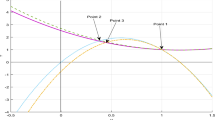Abstract
This paper presents the results of experimental and computational studies of instability development and mixing at the contact boundaries between gases of different densities. It has been shown that instability and mixing at two contact boundaries in a three-layer gas systems occur after a shock wave with a Mach number M = 1.3 that forms on the left end and moves along the tube has passed through the contact boundaries. Two experiments were performed, in the first of which the central layer was filled with a heavy gas (SF6 gas), and in the second experiment, it was filled with a light gas (helium). On the left and right of the central layer was air at atmospheric pressure. A comparison of the results was performed.











Similar content being viewed by others
REFERENCES
A. Subramaniam and S. K. Lele, “Numerical Simulation of Multi-Material Mixing in an Inclined Interface Richtmyer–Meshkov Instability," AIP Conf. Proc. 1793 150006 (2017); DOI: 10.1063/1.4971735.
E. V. Bodrov, V. V. Zmushko, N. V. Nevmerzhitskii, et al., “Computational and Experimental Investigation of the Development of Turbulent Mixing in a Gas Layering in Passage of a Shock Wave," Izv. Ross Akad. Nauk, Mekh. Zhidk. Gaza No. 3, 54–62 (2018) [Fluid. Dyn. 53, 385–393 (2018); https://doi.org/10.1134/S0015462818030059].
D. Drikakis, C. Fureby, F. Grinstein, and D. Youngs, “Simulation of Transition and Turbulence Decay in the Taylor–Green Vortex," J. Turbulence 8, 1–20 (2007).
S. Ukai, K. Balakrishnan, and S. Menon, “Growth Rate Predictions of Single- and Multi-Mode Richtmyer–Meshkov Instability with Reshock," Shock Wave 21, 533–546 (2011).
B. Olson and J. Greenough, “Large Eddy Simulation Requirements for Richtmyer–Meshkov Instability," Phys. Fluids 26, 044103 (2014).
R. Cohen, W. Dannevik, A. Dimits, et al., “Three-Dimensional Simulation of a Richtmyer–Meshkov Instability with a Two-Scale Initial Perturbation," Phys. Fluids 14, 3692–3709 (2002).
B. Thornber, D. Drikakis, R. Williams, and D. Youngs, “The Influence of Initial Conditions on Turbulent Mixing due to Richtmyer–Meshkov Instability," J. Fluid Mech. 654, 99–139 (2010).
A. Gowardhan and F. Grinstein, “Numerical Simulation of Richtmyer–Meshkov Instabilities in Shocked Gas Curtains," J. Turbulence 12, 1–24 (2011).
N. V. Zmitrenko, M. E. Ladonkina, and V. F. Tishkin, “Numerical Study of Turbulent Mixing for One Problem of the Development of Richtmyer–Meshkov Instability," Vopr. Atom. Nauki Tekh., Ser. Mat. Model. Fiz. Protsess., No. 1, 12–26 (2004).
O. G. Sin’kova, V. P. Statsenko, and Yu. V. Yanilkin, “Numerical Simulation of an Experiment to Study Turbulent Mixing after Multiple Shock Wave Passage through the Interface," Vopr. Atom. Nauki Tekh., Ser. Teor. Prikl. Fiz., No. 3, 17–22 (2004).
B. Haines, F. Grinstein, and J. Schwarzkopf, “Reynolds-Averaged Navier–Stokes Initialization and Benchmarking in Shock-Driven Turbulent Mixing," J. Turbulence 14 (2), 46–70 (2013).
F. Grinstein, “Initial Conditions and Modeling for Simulations of Shock Driven Turbulent Material Mixing," Comput. Fluids151, 58–72 (2017).
M. Hahn, D. Drikakis, D. Youngs, and R. Williams, “Richtmyer–Meshkov Turbulent Mixing Arising from an Inclined Material Interface with Realistic Surface Perturbations and Reshocked Flow," Phys. Fluids 23, 046101 (2011).
E. D. Senkovskii, N. V. Nevmerzhitskii, A. N. Razin et al., “Experiments on Turbulent Mixing in Three-Layer Gas Systems," inProc. Int. Conf. 9th Khariton Scientific Readings, Sarov, March 12–16, 2007 (Inst. of Exp. Phys., Sarov, 2007), pp. 637–642.
N. V. Nevmerzhitskii, A. N. Razin, Yu. A. Trutnev, et al., “Development of Turbulent Mixing in Three-Layer Gas Systems with an Inclined Contact Boundary," Vopr. Atom. Nauki Tekh., Ser. Teor. Prikl. Fiz., No 2, 12–17 (2008).
N. V. Nevmerzhitskii, A. N. Razin, E. D. Sen’kovskii, et al., “Study of Turbulent Mixing in Three-Layer Gas Systems by the Laser Method," Vopr. Atom. Nauki Tekh., Ser. Teor. Prikl. Fiz., No. 3, 44–54 (2009).
N. V. Nevmerzhitskii, A. N. Razin, E. D. Sen’kovskii, et al., “Study of Turbulent Mixing in Three-Layer Gas Systems," in13th Khariton Scientific Readings (Extreme States of Matter. Detonation. Shock Waves), Proc. Int. Conf., Sarov, March 14–18, 2011 (Inst. of Exp. Phys., Sarov, 2011), pp. 591–597.
N. V. Nevmerzhitskii, A. N. Razin, E. D. Sen’kovskii, et al., “Development of Turbulent Mixing Zones in Three-Layer Gas Systems under Conditions of Regular and Irregular Interaction of a Shock Wave with the Contact Boundary," in 13th Khariton Scientific Readings (Extreme States of Matter. Detonation. Shock Waves), Proc. Int. Conf., Sarov, March 23–25, 2015 (Inst. of Exp. Phys., Sarov, 2015), 722–745.
N. V. Nevmerzhitskii, A. N. Razin, E. D. Sen’kovskii, et al., “Experimental and Numerical Study of Turbulent Mixing at the Contact Boundaries of Three-Dimensional Gas Systems," Prikl. Mekh. Tekh. Fiz. 56 (2), 32–42 (2015) [J. Appl. Mech. Tech. Phys.56 (2), 192–201 (2015); https://doi.org/10.1134/S0021894415020042].
A. N. Razin, Simulation of Instability and Turbulent Mixing in Layered Systems (Inst. of Exp. Phys., Sarov, 2010) [in Russian].
N. V. Nevmerzhitskii, Hydrodynamic Instabilities and Turbulent Mixing of Substances. Laboratory Modeling (Inst. of Exp. Phys., Sarov, 2018) [in Russian].
V. V. Zmushko, F. A. Pletenev, V. A. Saraev, and I. D. Sofronov, “A Technique for Solving Three-Dimensional Equations of Gas Dynamics in Mixed Lagrangian-Euler Coordinates," Vopr. Atom. Nauki Tekh., Ser. Metod. Progr. Chisl. Reshen. Zadach Mat. Fiz., No. 1, 22–27 (1988).
I. D. Sofronov, E. A. Afanas’eva, O. A. Vinokurov, et al., “MIMOZA Software for Solving Multidimensional Problems of Continuum Mechanics on the Elbrus-2 Computer," Vopr. Atom. Nauki Tekh., Ser. Ser. Mat. Model. Fiz. Prots., No. 2, 3–9 (1990).
V. V. Zmushko, “Computation of Convective Flows and Their Realization in MIMOZA Code," in New Models of Numerical Codes for Shock Wave Processes in Condensed Media, Proc. of the Int. Workshop, Oxford, September 15–19, 1997 (Aldermaston, 1997).
V. K. Ladagin and A. M. Pastushenko, “One Scheme for Calculating Gas-Dynamic Flows," Chisl. Met. Mekh., Sploshn. Sredy8 (20), 66–72 (1977).
Author information
Authors and Affiliations
Corresponding author
Additional information
Translated from Prikladnaya Mekhanika i Tekhnicheskaya Fizika, 2021, Vol. 62, No. 1, pp. 43–54. https://doi.org/10.15372/PMTF20210105.
Rights and permissions
About this article
Cite this article
Bol’shakova, A.E., Zmushko, V.V., Nevmerzhitskii, N.V. et al. NUMERICAL SIMULATION OF INSTABILITY DEVELOPMENT AT THE CONTACT BOUNDARIES IN A THREE-LAYER GAS SYSTEM: COMPARISON WITH EXPERIMENTAL DATA. J Appl Mech Tech Phy 62, 38–48 (2021). https://doi.org/10.1134/S0021894421010053
Received:
Published:
Issue Date:
DOI: https://doi.org/10.1134/S0021894421010053




